
Maria Edgeworth was a prolific Anglo-Irish novelist of adults' and children's literature. She was one of the first realist writers in children's literature and was a significant figure in the evolution of the novel in Europe. She held critical views on estate management, politics and education, and corresponded with some of the leading literary and economic writers, including Sir Walter Scott and David Ricardo. During the first decade of the 19th century she was one of the most widely read novelists in Britain and Ireland. Her name today most commonly associated with Castle Rackrent, her first novel in which she adopted an Irish Catholic voice to narrate the dissipation and decline of a family from her own landed Anglo-Irish class.

The Absentee is a novel by Maria Edgeworth, published in 1812 in Tales of Fashionable Life, that expresses the systemic evils of the absentee landlord class of Anglo-Irish and the desperate condition of the Irish peasantry. There are many turns of plot and much information about Ireland as well as Irish dialect and details of shallow London fashionable life, and the egregious results of the propertied classes treating their Irish lands as a resource to be exploited rather than as a relationship among classes and with the land. In this respect, it addresses similar themes to her first novel, Castle Rackrent.
This article contains information about the literary events and publications of 1800.

Isabella Augusta, Lady Gregory was an Anglo-Irish dramatist, folklorist and theatre manager. With William Butler Yeats and Edward Martyn, she co-founded the Irish Literary Theatre and the Abbey Theatre, and wrote numerous short works for both companies. Lady Gregory produced a number of books of retellings of stories taken from Irish mythology. Born into a class that identified closely with British rule, she turned against it. Her conversion to cultural nationalism, as evidenced by her writings, was emblematic of many of the political struggles to occur in Ireland during her lifetime.
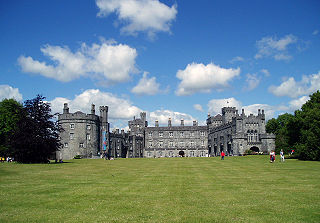
Kilkenny Castle is a castle in Kilkenny, Ireland, built in 1260 to control a fording-point of the River Nore and the junction of several routeways. It was a symbol of Norman occupation, and in its original 13th-century condition, it would have formed an important element of the town's defences with four large circular corner towers and a massive ditch, part of which can still be seen today on the Parade.
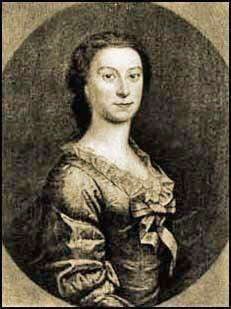
Esther Vanhomrigh or Van Homrigh, an Irish woman of Dutch descent, was a longtime lover and correspondent of Jonathan Swift. Swift's letters to her were published after her death. Her fictional name "Vanessa" was created by Swift by taking Van from her surname, Vanhomrigh, and adding Esse, the pet form of her first name, Esther.
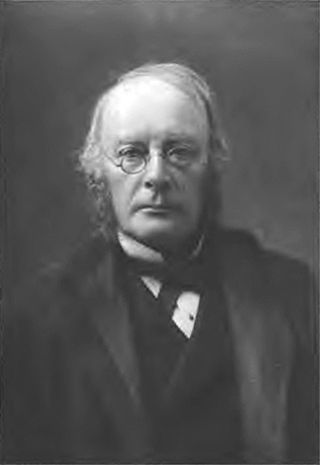
Sir Samuel Ferguson was an Irish poet, barrister, antiquarian, artist and public servant. He was an acclaimed 19th-century Irish poet, and his interest in Irish mythology and early Irish history can be seen as a forerunner of William Butler Yeats and the other poets of the Irish Literary Revival.
A Legend of Montrose is an historical novel by Sir Walter Scott, set in Scotland in the 1640s during the Wars of the Three Kingdoms. It forms, along with The Bride of Lammermoor, the 3rd series of Scott's Tales of My Landlord. The two novels were published together in 1819.
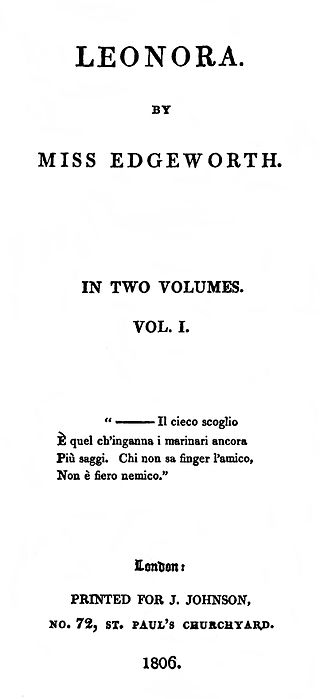
Leonora is a novel written by Maria Edgeworth and published in 1806.
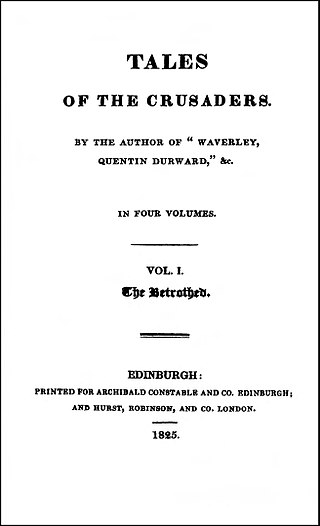
The Betrothed (1825) is one of the Waverley novels by Sir Walter Scott. Set in the Welsh Marches in the 12th century it is the first of two Tales of the Crusaders, the second being The Talisman.
Belinda is an 1801 novel by the Anglo-Irish writer Maria Edgeworth. It was first published in three volumes by Joseph Johnson of London. The novel was Edgeworth's second published, and was considered controversial in its day for its depiction of an interracial marriage. It was reprinted by Pandora Press in 1986.

Harrington is an 1817 novel by British novelist Maria Edgeworth. The novel was written in response to a letter from a Jewish-American reader who complained about Edgeworth's stereotypically anti-semitic portrayals of Jews in Castle Rackrent (1800), Belinda (1801), The Absentee (1812), and her Moral Tales (1801) for children. The novel is an autobiography of a "recovering anti-Semite", whose youthful prejudices are undone by contact with various Jewish characters, particularly a young woman. It draws parallels between the religious discrimination of the Jews and the Catholics in Ireland. Set between the Jewish Naturalisation Act of 1753 and the Gordon Riots of 1780, the timeframe highlights these connections.

Patronage is a four volume fictional work by Anglo-Irish writer Maria Edgeworth and published in 1814. It is one of her later books, after such successes as Castle Rackrent (1800), Belinda (1801), Leonora (1806) and The Absentee in 1812, to name a few. The novel is a long and ambitious one which she began writing in 1809. It is the longest of her novels.

Tristernagh Abbey, also known as the Priory of Kilbixy or Kilbisky, Tristernagh Priory, or the priory of the Blessed Virgin Mary of Tristernagh, is a ruined Augustinian monastery in the townland of Tristernagh in the barony of Kilbixy in County Westmeath, Ireland. It is situated on the shores of Lough Iron, about 3 kilometres (1.9 mi) north east of the village of Ballynacargy.
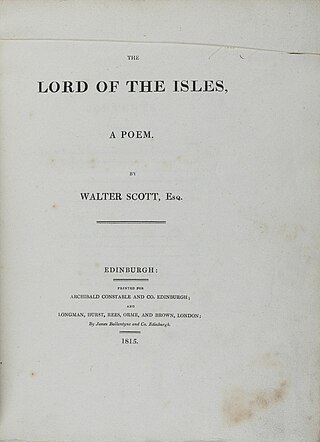
The Lord of the Isles is a narrative poem by Walter Scott in six cantos with substantial notes. Set in 1307 and 1314 Scotland it covers the story of Robert the Bruce from his return from exile in Ireland to the successful culmination of his struggle to secure Scottish independence from English control at the Battle of Bannockburn. Interwoven with this account is a romantic fiction centring on one of the Bruce's prominent supporters, Ronald, Lord of the Isles, involving his love for the Bruce's sister Isabel, who eventually takes the veil, and the transfer of his affections to Edith of Lorn to whom he had been betrothed at the beginning of the poem and whom he marries at the end.

Honora Edgeworth was an eighteenth-century English writer, mainly known for her associations with literary figures of the day particularly Anna Seward and the Lunar Society, and for her work on children's education. Sneyd was born in Bath in 1751, and following the death of her mother in 1756 was raised by Canon Thomas Seward and his wife Elizabeth in Lichfield, Staffordshire until she returned to her father's house in 1771. There, she formed a close friendship with their daughter, Anna Seward. Having had a romantic engagement to John André and having declined the hand of Thomas Day, she married Richard Edgeworth as his second wife in 1773, living on the family estate in Ireland till 1776. There she helped raise his children from his first marriage, including Maria Edgeworth, and two children of her own. Returning to England she fell ill with tuberculosis, which was incurable, dying at Weston in Staffordshire in 1780. She is the subject of a number of Anna Seward's poems, and with her husband developed concepts of childhood education, resulting in a series of books, such as Practical Education, based on her observations of the Edgeworth children. She is known for her stand on women's rights through her vigorous rejection of the proposal by Day, in which she outlined her views on equality in marriage.

Captain Rock was a mythical Irish folk hero, and the name used for the agrarian rebel group he represented in the south-west of Ireland from 1821 to 1824.
Elizabeth Preston, Countess of Desmond and 2nd Baroness Dingwall was the only daughter of Thomas Butler, 10th Earl of Ormond, called Black Tom, a lone Protestant in his Catholic Old English family. Her marriage and inheritance were manipulated by James I to keep Black Tom's inheritance out of the hands of his Catholic successor, Walter of the beads and bring them into the hands of his Scottish favourite Richard Preston, Lord Dingwall.
Kathryn Kirkpatrick is a poet, scholar, and English professor at Appalachian State University. Her works of poetry focus on the natural world and the ways humans interact with nature, and the ethical treatment of animals. As an academic, she also specializes in Irish literature and culture, which is a common theme in her published works. She has received several awards for her poetry collections.
Ennui is a novel by Maria Edgeworth published in 1809. It is a fictitious memoir of the Earl of Glenthorn, an English man who experiences excessive boredom (ennui) and attempts to find novelty and meaning in life. Edgeworth began writing the novel before 1805, and though she said she finished it that year, she likely continued revising it until around 1808.















